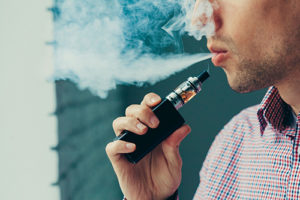 It’s not uncommon for a person in addiction recovery to still smoke cigarettes; a 2011 study found that between the years of 1987 and 2009, the lowest smoking prevalence of any single year for those in addiction recovery was 65% – and while we don’t talk much about cigarettes in recovery, it’s a topic worthy of discussion. In 2018, the National Institute on Drug Abuse (NIDA) exclaimed that those who smoke cigarettes upon entering treatment and who were still smoking 3 years later were about 1.5 times more likely to use drugs and twice as likely to have a substance use disorder (SUD) after treatment follow-up than those who quit smoking. Heavier smokers are more likely to relapse, but with the latest technology of vape pens hitting the market, how does this affect relapse rates for those in recovery?
It’s not uncommon for a person in addiction recovery to still smoke cigarettes; a 2011 study found that between the years of 1987 and 2009, the lowest smoking prevalence of any single year for those in addiction recovery was 65% – and while we don’t talk much about cigarettes in recovery, it’s a topic worthy of discussion. In 2018, the National Institute on Drug Abuse (NIDA) exclaimed that those who smoke cigarettes upon entering treatment and who were still smoking 3 years later were about 1.5 times more likely to use drugs and twice as likely to have a substance use disorder (SUD) after treatment follow-up than those who quit smoking. Heavier smokers are more likely to relapse, but with the latest technology of vape pens hitting the market, how does this affect relapse rates for those in recovery?
What is Vaping?
Dr. Linda Richter, an expert on nicotine and drug addiction, explained vaping as,
“…The act of inhaling and exhaling the aerosol, often referred to as vapor, which is produced by an e-cigarette or similar device.”
A common misconception is that vapors release water vapor, when they really release an aerosol of fine particles that could range in toxic chemicals. E-cigarettes are what led to the development of vaping pens and more; Juul is the best-selling e-cigarette on the market – but unfortunately, it’s showing as though people are becoming more addicted to this type of device rather than using it as a quitting mechanism. E-cigarettes and vape pens have gained more traction in marketing as they’re simpler in design and typically less expensive than devices that may be customized by a person. Last year, Business Insider highlighted several of the ingredients that are included in these types of vaping devices:
- Nicotine (which is highly addictive)
- Propylene glycol (typically found in ice cream and coffee drinks)
- Glycerine (a liquid sweetener)
- Flavorings
In 2018, Yale Medicine emphasized that teens are abusing these types of devices significantly – with some even bragging to their friends about being able to smoke in the classroom or in the bathroom at school. Vaping is marketed as a “safe alternative” to smoking traditional cigarettes, but there are little regulations to determine exactly how much nicotine is placed in each vaping device – and depending on how quickly a person vapes, they may be consuming more nicotine that could translate up to a pack of cigarettes in one day – whether they realize it or not.
Vaping and Addiction Recovery
Many in recovery don’t want to quit the bad habit of smoking because in their mind, they’re already taking a huge undertaking in quitting a major addiction that’s caused many problems in their life – and the thought process tends to be, “Smoking (or vaping) isn’t going to be that big of a deal compared to what I was doing before”. Despite this belief, those in recovery may be jeopardizing their success by increasing their relapse rates and potential for developing a SUD later on in life. Very Well Mind, a website that provides information on disorders, self-improvement and more, described the story of a woman who went through a lot – such as through the death of her husband – and who struggled with both nicotine addiction and alcoholism. It took her several years of working up towards freeing herself from nicotine addiction, and she found that in doing this, she was much better able to live a life that was free from the reins of addiction altogether. The story stated,
“While Maggie had 22 years of sobriety, she found that her escape from nicotine addiction was a fragile freedom. Yet she believes that if she stays humble, maintains a peaceful vigilance, and tries to help others who desire to recover from nicotine addiction, she will remain a non-smoker.”
While vaping may potentially be less harmful than traditional cigarettes, that doesn’t mean they don’t come with their own set of negative health effects. Nicotine raises your blood pressure and spikes up your adrenaline – e-cigarettes and other vaping devices also expose you to a host of chemicals that haven’t been studied enough to ensure that you’re protected in the best way. Vaping devices don’t help people quit – in fact, between the nicotine and the flavors created by manufacturers, individuals are more likely to stay hooked on vaping. Lastly, there’s always a strong association between smoking and cardiovascular disease – addiction recovery is the perfect time to start emphasizing ultimate health and wellness.
Pick Up Healthier Habits
To really help transition from smoking to not smoking, start small. Cut down on the total number of cigarettes smoked in a day little by little – and rely on the support system around you in recovery for help. Dairy products (such as milk) are topics choices to reach for if you’re craving cigarettes, because most people don’t find cigarettes palatable after drinking a cold glass of milk. Eat plenty of fruits and vegetables and lean towards frozen grapes to help with cravings as well.
It may feel like vaping is a minor concern in recovery, but it can have a huge impact on your health over time.
Cumberland Heights is a nonprofit alcohol and drug-addiction treatment center located on the banks of the Cumberland river in Nashville, Tennessee. On a sprawling 177-acre campus, we are made up of 2 12-Step immersion campuses, 12 outpatient recovery centers and 4 sober living homes. We believe that each person has a unique story to tell – and that’s why we always put the patient first.










